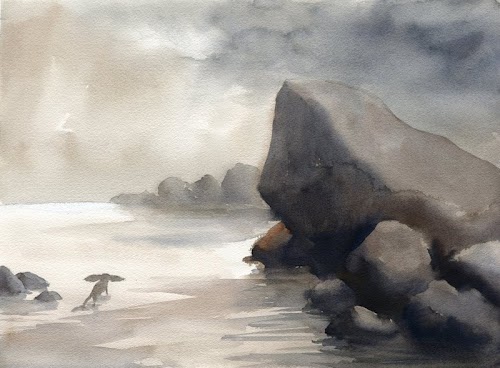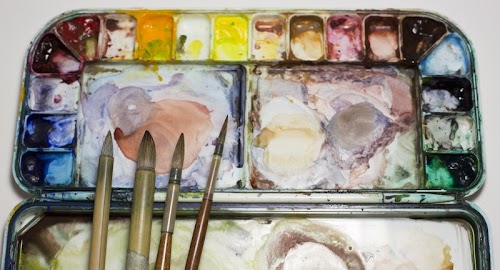Art Tools of Audran Guerard
For this interview, we have Audran Guerard with us. He's a visual artist with prior experience as an art director for Ubisoft and Electronic Arts. Recently. he has launched a Kickstarter campaign for his watercolour graphic novel The Life of Frederick Douglass. I though it would be interesting to find out what he uses to create art.
Qn: What are your favourite drawing tools? Any particular brand of pens, pencils, markers, watercolours, etc?

For drawing, I like using a Staedtler 2.0mm technical pencil. It doesn't need to be sharpened often. I can draw at an angle so the tip stay pointy. It's also heavier and feel nice to hold. I use 2B graphite, anything harder will damaged the sensitive watercolour paper, any softer will smudge too much. It's a nice balance.

For the brushes, I think the secret is to find what suits your own style. I've been recommended expansive brushes that I never use. I tried Chinese brush, kolinsky brush, and many others, finally what really suits me is a type of brush I found only in Japan, very cheap too. Actually mines are so old, I need new ones, if anyone from Tokyo is reading this... I need someone to stop at Sekaido for me, Lol.

Theses are the 4 brushes I use the most, 2 Japaneses Brushes, made with bamboo, and the two others are Kolinsky, also called Red Sable brushes.
The characteristic I really like in a brush is the spring and it capacity to hold plenty of water.

Qn: You've chosen watercolour to create your graphic novel The Life of Frederick Douglass. Why choose watercolour?
For me watercolour is the fastest way to express myself, visually that is. I quite never really got hooked on digital painting. I can do it, I do it sometime, but it feels 10x more laborious to me.
To make a quick gradient in watercolour is so easy. Water does all the work for you. Its really important to understand how various pigment will mix, and then it becomes like a language in which you don't need to think before speaking, it becomes natural.

I got drawn into watercolour by a book written by the great Charles Reid, The Natural Way to Paint (US | CA | UK | DE | FR | IT | ES | JP).
I was looking at the cover, and thought to myself "Hey that should be easy enough!" I couldn't be more wrong. I kept at it...after 3 years of despair and hundreds of books later. I started to understand. It was a combination of many things. At the same time, I was learning to see, learning to draw, learning the technicality of watercolour and I was learning to paint.
I eventually started a blog to record my progress. In the end, my best work is when I'm fearless, and let the water do the work.
When I get worried or stress on the outcome, I apply greater control and the water is unable to operate, and the painting end up being a coloured drawing, stiff and lifeless.
Qn: There are quite a lot of watercolour art on your blog. Have you experimented with different brands?
I started with pans, then graduated to tubes. Pans are really hard to revive and it's harder to get rich saturated or dark tone using pans. Tubes give more punch.
I use Graham & Co watercolour tubes. They have a very high density of pigments, so a little goes a long way. Honey is used in their composition, so they remain moist and never cake in my palette.
Other brands of watercolour will dry out and crack. It need lot of effort to revive them. Painting is hard enough, I don't need to fight my equipment on top of it. Graham & Co Watercolors remains consistently moist and are always ready to meet my brushes. Plus, the factory making them operate with very tight environment friendly rules. That's a big win in my book.
Qn: How do you colour correct your watercolour scans? What do you use? How do you get it to match on screen to exactly what's on the paper, as some scanners are unable to scan the texture of watercolour paper.
This is something I'm still trying to figure out. I believe my watercolour looks better on paper. I've been unable to match them perfectly on screen. After being scanned, something gets lost.
The only thing I can do, is digitally push the watercolour in a way to regain some appeal. Maybe better contrast, play a bit with the saturation, trying to compensate for the loss that happens at the scanning.
But that said, only I can do the comparison, People can look at my digital files with no reference to what they are originally.
Qn: Do you use any sketchbooks or draw on loose sheets?
I draw on whatever is at hand. I could use paper from a printer, or use a sketchbook.
But when I want to do fast watercolour studies, like life drawings, nothing beat the Aquabee Deluxe sketchbook, it has a velvet like surface that holds water very well.
For more "Serious" things, I use Arches watercolour paper (140lbs / 300gsm), I like the rough surface of the Cold Press for texturing, but sometime when you need fine details, the Hot Press is better suited.
Qn: You're a visual artist who has worked for video game companies like Ubisoft and EA. Do you use different tools to create art there? If so, why the different tools?
Sometime I would go digital, sometime I would go watercolour. The important thing is not the medium, it's the content. A sketch is a communication tool, it express an idea. How you deliver that message is up to you. As long as your message is well received on the other side.
Qn: Have you bought any art supplies that you were excited about, only to try it and find out you don't like it as much as you expected?
Yes I have lots of it...brush, sketchpad, oils, acrylics, I think it really important to explore and experiment, its surely not a cheap process. But its the only way to understand what really works for you.
Before I would run and buy gear that famous artists used. You may really like an artist, but his ways are not yours. It's fine to study and understand their process, it's actually really good, but don't get obsessed. Don't cage yourself in a style or in a technics. Explore, experiment, more importantly have fun, and slowly you will build an array of tools and practice that make your art, yours.

Check out other artist interviewees at https://www.parkablogs.com/tags/art-tools-and-gears


